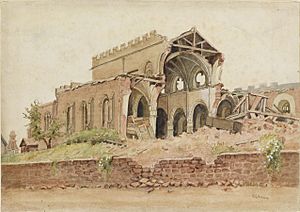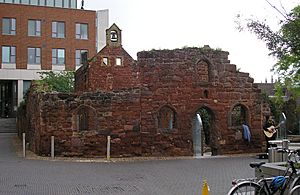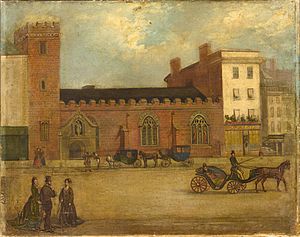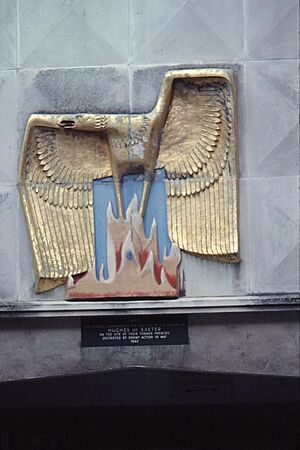Exeter Blitz facts for kids
The Exeter Blitz was a series of air attacks on the city of Exeter, Devon, in Britain. These attacks happened during World War II. German planes from the Luftwaffe (Germany's air force) bombed Exeter. The main attacks took place in April and May 1942. They were part of special raids called the "Baedeker raids". In these raids, the Germans chose cities to bomb because they were culturally or historically important. They were not chosen for military reasons.
First Attacks on Exeter
The first German air raid on Exeter happened on 7 August 1940. This was early in the Battle of Britain. A single German plane dropped five bombs. They fell on the St Thomas area of the town. Not much damage was caused. The local newspaper reported one person was hurt. A pet canary and some chickens were also killed.
Over the next 18 months, Exeter faced 18 more raids. These were mostly quick attacks by single planes. Exeter was not heavily hit during the Blitz. The Blitz was a big German night-bombing campaign against British cities. However, nearby Plymouth was badly damaged in early 1941.
Things changed in 1942. Exeter became the first target of the "Baedeker Blitz". This was a new bombing campaign. Its goal was to attack places that were culturally or historically important. These raids were a way for Germany to get back at Britain. The RAF (Britain's Royal Air Force) had bombed the German city of Lübeck earlier that year.
April 1942 Bombings
On the night of 23/24 April 1942, 49 German bombers attacked. They were from groups like KG2 and KG106. Special pathfinder planes from I/KG100 led the way. But there were heavy clouds. Most of the bombers missed their targets. Not much damage was done.
Seven bombs fell on the St Thomas and Marsh Barton areas. About 200 houses were damaged. Five people were killed and eight were injured. One German plane, a Do 17, was shot down. An RAF night fighter, a Beaufighter from 604 Squadron, shot it down.
The next night, 24/25 April, was clear. Two waves of 20 bombers attacked again. Many planes flew two missions that night. Visibility was good, and they flew low. There were no anti-aircraft guns to stop them. They hit the city hard, especially the Pennsylvania area. 73 people were killed and 54 were injured. Four German planes were shot down. Three were shot down by night fighters. One was shot down over Portland by anti-aircraft fire.
After these attacks, the Luftwaffe bombed other cities. They attacked Bath, York, and Norwich. They returned to Exeter in early May.
May 1942 Bombings

On the night of 3/4 May 1942, just after midnight, 20 bombers arrived. They flew over the town centre. In just 70 minutes, they destroyed the town centre and Newtown area. Bombs fell on High Street, Sidwell Street, and Fore Street. Fires started in houses and shops. These fires quickly grew out of control.
Firefighters and emergency services worked hard to stop the fires. They faced danger from unexploded ordnance (bombs that had not gone off). German bombers also flew low and fired their guns at them. Fire services from Torquay and Plymouth came to help. In total, 195 fire engines and 1,080 people worked to control the fires. They mostly got the fires under control by 5 May. But small fires kept starting until midday on 7 May.
About 30 acres (12 hectares) of the city were destroyed. 156 people were killed and 583 were injured.
In the city centre, much of Bedford Circus was destroyed. The top of High Street and parts of Sidwell Street and Paris Street were also ruined. Another area at the top of Fore Street and much of South Street were also wiped out. Between these two areas, the Cathedral was hit by only one bomb. It destroyed St James's Chapel on its south side. The City Library, which held over a million documents and books, was destroyed. The Vicars Choral College was also ruined.
One bomb fell in Hoopern Fields near the university. The crater from this bomb can still be seen today.
In total, 1,500 of the city's 20,000 houses were completely destroyed. Another 2,700 houses were badly damaged. Also, 400 shops, almost 150 offices, 50 warehouses, and 36 pubs were destroyed.
After the Blitz
After the raid on 3/4 May 1942, German radio made a bold statement. They said, "Exeter is the jewel of the west; we have destroyed that jewel, and we will return to finish the job." But despite this boast, the May 1942 air raid was the last one Exeter suffered. Germany's Baedeker Blitz continued for two more years. But it became less and less effective. This was because the RAF's night fighter defences grew stronger.
In total, the nineteen air attacks on Exeter caused many casualties. 265 people died, and 687 were injured. 111 of the injuries were serious. A large part of the city centre had been destroyed. It took about 20 years for repairs to be fully completed. This led to a completely new layout for the city centre.




